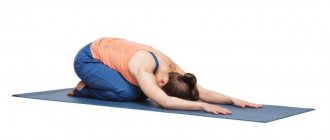“Why did you go to the bathhouse? Don’t you have a bath at home?” - Ippolit asked the unlucky Lukashin in the film “The Irony of Fate, or Enjoy Your Bath!”
In Soviet times, few knew that the bathhouse was a powerful physiotherapeutic procedure that could both improve human health and harm it. The director of the Institute of Health and Rehabilitation Sciences of NSU says Lesgafta, Doctor of Medical Sciences, Professor Andrey Kalinin .
— The bath procedure activates thermoregulation. When a person enters a steam room, his body temperature rises, blood vessels dilate, skin cleanses, and skin respiration intensifies. Together with sweat, electrolytes, metabolic products and excess fluid leave the body. Staying in a bathhouse enhances inhibitory processes in the central nervous system, causing a sedative (calming) effect. The endocrine system perceives “general inhibition” as stress and activates the function of the endocrine glands, increasing the production of hormones. Therefore, after a bath, a person experiences a feeling of relaxation and vigor at the same time.
Article on the topic
Steam for the “clean” public. How the first bathhouse appeared in Moscow The steam room is an excellent exercise machine for the heart and blood vessels. Studies have shown that bathhouse regulars have a lower risk of developing hypertension than those who bypass it. The sauna also has a beneficial effect on the respiratory system. Under the influence of heat, the bronchi expand, the frequency and depth of breathing increase, which activates heat transfer and compensates for the lack of oxygen in the internal organs.
Dousing yourself with cool water after a steam room deserves a separate discussion.
When immersed in cold water, the vessels first narrow (blood from the periphery rushes to the internal organs), and when the blood flow is directed in the opposite direction, they expand. During short-term douches, water does not have time to take away enough heat, but it has a powerful effect on the nervous system (increasing its tone, which allows you to remain calm in difficult situations) and on the immune system. However, the powerful physiotherapeutic bath effect can only be used if there are no contraindications.
Principles of exposure and therapeutic effect of the bath
Our grandparents loved to have a swim day. The procedure has a strong effect on the body, but at the same time brings great benefits. Warm, humid air causes you to sweat, and sweat releases toxic substances.
The bathhouse has a positive effect on a person:
- Thermoregulation. High temperature destroys viruses, germs and bacteria. Slows down the growth of malignant cells.
- Metabolism. Improves metabolism.
- Leather. Cleanses the skin of toxins and impurities.
- Ships. Temperature changes train blood vessels, making their walls strong. The heart muscles become stronger.
- Nervous system. Blood begins to circulate better due to the expansion of blood vessels. This has a relaxing effect on a person.
From the above we can conclude that the bathhouse is beneficial for human health.
But what should people with high blood pressure do? Will you have to give it all up because of higher rates? To understand whether patients with high blood pressure can visit a sauna or bathhouse, you need to understand the disease itself and reconsider your lifestyle.
Is a bath useful for hypertensive patients?
From 1000 rub./hour. 12 people
From 1000 rub./hour. 12 people
From 800 rub./hour. 8 people
| Is a bath useful for hypertensive patients? |
- 3D tour
- Baths
- Services
- Promotions and news
- Kitchen
- Articles
- Contacts
- Top 6 questions about the bath
- TOP 5 autumn films
- Meals at the Republican Baths
- Heating of our bath complexes
- Is a bath useful for hypertensive patients?
- 9 reasons to visit a sauna for pregnant women
- 6 rules to stay young
- 6 original bath options
- 7 summer movies to watch in the bathhouse
- Treatment of bath rooms
- 6 ways to survive pressure testing
- 6 rules that will prolong your youth
- Cleansing masks for face and body
- Body scrub in bath
- It's time for bathing holidays and corporate events
- 5 reasons to go to a summer bath
- 5 reasons to use aromatherapy in the bath
- 7 soulful films to watch in the bathhouse
- 7 ways to care for your lips in a bath
- Taking care of the skin around the eyes in a bath
- 7 romantic films to watch in the bathhouse
- May holidays in the bathhouse
- 5+ important rules for visiting the bath complex
- 5 films with an exciting plot for a bathhouse
- Body scrub in bath
- 7 ways to tighten your belly skin
- 5 films with an exciting plot to watch in the bathhouse
- Bathhouse is a great anti-stress
- 3 anti-cellulite procedures in the bath
- How to properly care for your feet in a bathhouse
- Let's steam and eat in the sauna!
- 4 ways to effectively tighten your abdominal skin in a bath
- 10 life hacks on how to quickly cure a cold in a bathhouse
- 8 tips for a pleasant relaxation in the sauna on Friday evening
- 7 original bath traditions of the world
- 10 tips to keep your skin youthful
- 5 ideas to celebrate the New Year in a bathhouse
- 5 films with an exciting plot to watch in the bathhouse
- Bath is a painless way to get rid of unnecessary hair on the body
- 7 ways to take care of your hair
- 5 facts about the right bath broom
- All about the children's bath
- How to use essential oils in a bath
- Bath - benefits for flexibility and elasticity
- 5 ways to take care of your body
- 5 light bath films
- 9 ways to take care of your skin in autumn
- Top 5 films to watch in the bathhouse
- Top 10 films to watch in the bathhouse
- 6 options for what to do in the bathhouse
- 9 reasons why those losing weight should go to the bathhouse
- Rules for steaming in a Russian bath
- Rules for using a broom in a bathhouse
- Features of steaming in a sauna
The bath is a health procedure, but we recommend that people who suffer from chronically high blood pressure treat it with caution. In this article we will tell you whether hypertensive patients can go to the bathhouse and how to do it.
Unsuspecting hypertensive patients take a steam bath or go to a sauna, and then feel bad - their blood pressure rises sharply. This state of health directly depends on the body’s exposure to high temperatures and high humidity.
What happens to a hypertensive patient in a bathhouse:
- blood flow through the vessels accelerates - blood vessels dilate - heart rate rises to 140/70 beats per minute - vessel walls weaken and cease to resist external stimuli. After bath procedures in hypertensive patients, the upper pressure remains high, and the lower pressure drops even lower.
Is the bath recommended for hypertensive patients?
The bath is not contraindicated for all people with high blood pressure, if you follow a few important rules. It can be a good preventive measure in the fight against hypertension and may even improve your condition.
General benefits of bath procedures:
- thermoregulatory processes in the body are improved - the skin and muscles are saturated with oxygen - all toxins and harmful substances are removed - the respiratory and cardiovascular systems are strengthened - the skin improves - the skin becomes soft and elastic (promotes hematopoietic function) - the nervous system relaxes.
Rules for visiting baths and saunas
Whether hypertensive patients can or cannot take a steam bath depends on two factors:
- what stage the disease is at - type of bath.
Stage of disease development
Stages 3-4 are the most severe, progressive, and the pressure increases to the highest possible levels. Bath procedures are contraindicated, there is a high risk of death.
Stage 2 - moderate, vaping is possible, but it is important to monitor your condition. In addition, there is a certain time of day when the condition of a hypertensive patient worsens, so choose the right time to go to the bathhouse. Before going to the bathhouse, measure your blood pressure; if it is elevated, wait until it returns to normal or postpone the bathing day to another time.
Stage 1 is reversible; bath procedures can be combined with steaming.
Type of bath
Not all baths are equally useful for hypertension. Possible bath parameters: - air temperature in the bath - no more than 50-80°C - air humidity no more than 25-30%. So, at: 50-80°C - humidity 25-30%, at 90°C - 15%.
Based on these parameters, the following baths are possible for hypertensive patients:
— A dry bath (dry wind, Finnish) is the most gentle, since it has almost no effect on the physiological processes of the body, and also does not raise the pulse above 120 beats per minute. — Turkish hammams. - Wet hot baths (traditional Russian steam room) - but with extreme caution and not for too long, since such baths disrupt metabolic processes in the heart muscle and sharply increase the pulse to 160 beats per minute.
General bath rules
- visit the bathhouse in company (if you feel unwell, they will be able to help you) - before going to the bathhouse, do not drink alcohol, caffeine-containing and diuretic drinks and medications - between approaches, do not exert yourself physically - exclude contrast showers - do not use medications that lower blood pressure during steaming - wear a headdress to the sauna - eat 2 hours before going to the sauna - drink only herbal/chamomile tea between approaches - rest between approaches
If you feel bad in the bath:
- take the patient out of the bath - sit him comfortably in a semi-lying position - eliminate the noise, ensure complete rest - put a cold compress on the head - if the patient does not feel better, call an ambulance - have pills that control hypertension on hand.
Contraindications to the bath for hypertensive patients
Baths are strictly prohibited for: - 3-4 stages of development of hypertension - acute conditions, peaks of the disease and crises (acute viral and respiratory diseases; elevated body temperature; renal failure and others) - diseases of important systems of the body and its organs (especially the heart and blood vessels, since in the steam room the human heart works at maximum).
When deciding whether to take a steam bath or not, base it on your feelings and the recommendations of your doctor. Do not under any circumstances act to your detriment - if you really want to go to the bathhouse, but at the moment due to health reasons you cannot do it, arrange a bathhouse day at home.
We wish you a speedy recovery. Taking care of you, Republican Baths.
The effect of bath procedures on blood pressure
A person who has never taken a bath before wonders whether exposure to hot steam causes or reduces hypertension? It all depends on the type of couple, because each of them affects the body in its own way. A steam bath with moist air and a dry sauna are two different phenomena. In either case, heat causes the human heart to beat, and as a result, blood pressure rises.
Heat causes the heart muscles to contract much more quickly. If you reduce the air humidity, the effect will be different. Some people cannot stand the conditions of a steam room and prefer a sauna. It is safer for high blood pressure. Low blood pressure is also a contraindication to visiting the sauna.
For hypertension
People suffering from symptoms of hypertension do not refuse to visit the sauna. A few minutes in a steam bath can affect your blood pressure and cause it to drop. Moreover, the decrease in value occurs smoothly or there is a sharp jump. Everyone's body is different, so it is impossible to predict exactly how the procedure will affect a patient with high blood pressure.
Changes in blood pressure may be accompanied by a number of symptoms:
- weakness;
- nausea;
- dizziness.
If this happens every time you take a bath, there is no need for further treatment.
People ignore such situations without asking whether they could negatively affect their health. If a hypertensive patient gets sick and loses consciousness, there is a high probability of injury from a fall. Therefore, people with hypertension are advised to limit the number of bath visits.
For hypotension
Excessive use of baths is also contraindicated for people with hypotension. If a person cannot give up the habit of mating with friends in a bathhouse, then after the procedure it is better to eat dark chocolate or drink sweet tea. True, if you have hypotension, visiting the steam room is also not recommended, but this condition is much safer. Warm air can cause blood pressure to drop rapidly to critical levels.
Compatibility of hypertension and baths
Despite the prohibitions, a person has the right to visit the bathhouse. At the same time, you should remember about special rules, compliance with which will protect a person from negative consequences. Before visiting the steam room, you should measure your blood pressure. If they are normal, also listen to your body, there are no unpleasant sensations in it.
Physical weakness, headaches and nausea - it is better to postpone visiting the sauna until later. However, if the patient feels well, his condition can change at any time. To safely survive any changes in the body, it is worth having a first aid kit. Containers with medications should not be brought into the steam bath; they should be kept within walking distance.
What to do in an emergency?
Not paying attention to the rules of use means exposing yourself to the risk of a stroke. In case of complications, loved ones should provide immediate assistance.
If the patient suddenly becomes ill, he is immediately taken out into the air. First of all, ice is placed on the head, then medical help is called.
Among the medications, you can give antihypertensive and sedatives prescribed by your doctor. A person should be in peace and quiet.
The steam will be light and your health will improve if you listen to your well-being. You need to remember about the illness and, when going to the steam room, do not discount the requirements that are important for life.
Tags: well-being, rules of behavior, bathhouse, Russian bathhouse, hypertension, health benefits, rules of use
How to steam properly with hypertension
Dry air is easier for people with hypertension, so wait until it cools down before entering the steam room.
During heat treatment, the following rules should be taken into account:
- Stay in the room for no more than 5 minutes. After leaving the room, rinse with warm water.
- Just maintain a horizontal position.
- A calming and healing effect can be achieved with the help of an oak broom. It is steamed and the air is slowly distributed throughout the room.
Professionals strongly advise against staying indoors for long periods of time. It is better to divide a large period into several smaller ones.
The most suitable time intervals for inhalations:
- first - 2 minutes;
- second - 3 minutes;
- third 5 minutes;
- fourth 7 minutes;
- fifth - 2 minutes.
Each subsequent run is 1-2 minutes longer, the last one is the same as the first. Herbal tea supports thermoregulation in the body. It is advisable to choose linden flowers for brewing. Cover your shoulders with a towel and your head with a hat.
To protect a person from unforeseen situations, choose close friends to accompany you. They will monitor a person with hypertension and help him at the right time.
Visiting the bathhouse and sauna depending on the stage of hypertension
This disease has three stages:
- First. The person feels well. Blood pressure goes beyond normal limits under the influence of provoking factors - overload, stressful situations, physical activity. At such moments it increases. When a person calms down, everything returns to normal and there is no need for treatment.
- Second. Blood pressure periodically increases. You can return to optimal values with the help of medications.
- Third. Blood pressure is constantly outside the normal range. Increased levels require constant medication. You should have a tonometer on hand to check your pressure gauges.
In the first case, you can visit the sauna regularly, but you should monitor your physical sensations. If a patient is diagnosed with second-degree hypertension, doctors do not recommend frequent visits to the steam room. Good health allows you to carry out thermal procedures. In the latter case, bathing is very undesirable, as it can harm a person.
In what cases is it allowed, and when is it not, and why?
Can
Hypertensive patients with stage I of the disease will benefit from a bath - it will contribute to the overall improvement of the condition and health of the body and strengthen the walls of blood vessels.
And also read on our website: How is screening done for hypertension? Standards, forms and diagnostic methods
To know for sure whether you can visit the steam room, you must consult a doctor and get the appropriate recommendations, and also find out if you have other diseases for which going to the bathhouse is strictly contraindicated, for example, diabetes, etc.
If the patient has stage II hypertension, the doctor will base his decision on visiting the steam room on daily blood pressure readings and the frequency of hypertensive crises.
It is forbidden
A visit to the bathhouse is permissible only after a thorough examination of the patient, as well as after consultation with a cardiologist and therapist.
If you ignore doctors' recommendations, there is a high risk of aggravating the patient's condition and causing fainting and even a stroke. Such consequences can overtake a hypertensive patient not during bath procedures, but several hours later.
Immediately
before going to the steam room, it is necessary to find out the patient’s blood pressure at the moment and, even if it is normal, jumps in temperature in the room during bath procedures are unacceptable.
Visiting a bathhouse during a hypertensive crisis is strictly contraindicated.










